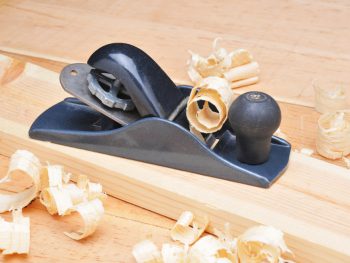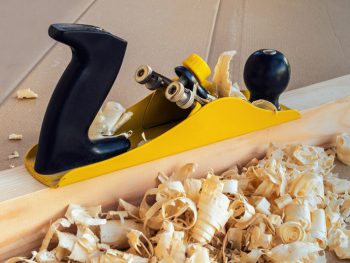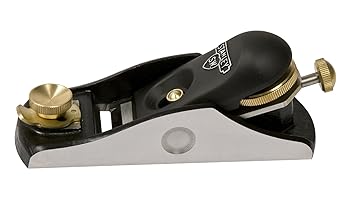 Especially if you are a carpenter, then perhaps you have done your fair share of producing all sorts of woodwork, from practical matters like chairs, tables, and closets to more refined, even creative, items like sculptures or elaborate designs.
Especially if you are a carpenter, then perhaps you have done your fair share of producing all sorts of woodwork, from practical matters like chairs, tables, and closets to more refined, even creative, items like sculptures or elaborate designs.
You probably have tons of experience in the woodworking field, and not only that, but also you are extremely passionate about it, dedicating your free time to side projects.
That said, when it comes to carpentry, you have probably used a ton of different tools to help you produce some of the best crafts out there. From hand saws to hand planes, the sheer number of objects for woodworking is never-ending, but all necessary for doing so.
You have probably lately come across block planes, a subset of hand planes that is unique in its cutting and supporting abilities. You are interested in getting one, but are not sure how to get started.
However, there is no need to fear, because we will help you out! Read on to learn more in this article on how to choose the best block plane for you, as well as get suggestions from us to do so. Soon enough, you will be well on your way to an even better carpentry experience.
Without further ado, let’s get started!
Comparison of Top 5 Best Block Planes 2021
**Below, you’ll find more detailed reviews but you can also click links above to see current prices and read customer’s reviews on Amazon.
Reviews of the Best Block Planes
Stanley 12-138 Bailey No.9-1/2 Block Plane
With a precision base for accuracy, Stanley’s 12-138 block plane is sure to produce some of the cleanest and most accurate cuts of wood that you can be proud of having.
Not only that, but also it has iron casting for weight and durability, so that it does not slip and slide everywhere when in operation. Finally, it has a mouth adjustment for different wood thickness, so you can use it for just about anything.
Pros
- Has a precision base for producing accurate, sharp cuts of wood.
- Made from iron casting for weight and durability.
- Has a mouth adjustment for different wood thickness.
Cons
- Lever cap tends to slip out, which can be a safety hazard.
Senkichi Japanese Wood Block Plane
Set up by a friction fit, Kanna’s block plane is sure to be an easy and convenient way to prepare for operation, as well as ensure a smooth, effortless one in the process.
Aside from that, it is great for both fine cuts and chamfering, so that it is incredibly versatile in terms of its usage in whatever project you choose to do. Unique in design and function, Kanna’s block plane might be a good choice.
Pros
- Set up by friction fit, which makes it easier to insert and remove.
- Great for all sorts of operations, e.g. fine cuts and chamfering.
- Requires no pins and wedges to be used.
Cons
- Inserting the blade in might be a bit tight, let alone difficult to do.
Stanley 12-139 Bailey No.60-1/2 Low Angle Block Plane
(Editor’s Choice)
Stanley 12-139 Low Angle Block Plane consists both a base and frog cast that are merged into one for convenience and accuracy. Besides that, it has a heavier body for stability, along with a mouth adjustment for all sorts of wood you can potentially feed into it.
Pros
- Contains both a base and frog cast for accuracy and convenience.
- Has a heavier body for stability.
- Has a mouth adjustment for different types of wood.
Cons
- Fitting in the blade can be a struggle.
Sheffield 58452 3 Inch Block Plane
Sheffield’s block plane might be small, but it certainly packs a powerful punch when it comes to trimming and chamfering projects.
It is made from S-2 steel for incredible durability, as well as comes with a die cast body and contoured shape for comfort and easy gripping. Finally, its two-piece design gives extra strength to all sorts of wood cut, able to satisfy you in the end.
Pros
- Made from S-2 steel for durability.
- Comes with a die cast body and contoured shape for comfortable gripping.
- Has a two-piece design for extra strength in cutting.
Cons
- Blade adjustment can be a bit of a hassle for some users.
KAKURI Mini Kanna Wood Block Plane
Made in Japan, Kakuri’s wood block plane measures at just 42 millimeters, but it is very powerful to use. You will be surprised to find out just how solid it is, for it is made from carbon steel and able to cut through just about anything you feed it.
Aside from that, its power and sharpness are sure to make it a strong candidate for your woodwork projects.
Pros
- Made from carbon steel for durability.
- Small and compact at 42 millimeters.
- Is powerful and sharp for any type of wood.
Cons
- Wedge of the blade is a bit too loose.
Things to Consider Before Purchasing a Block Plane

It is not a matter of rushing into it and picking the first one that catches your eye: rather, you will need to make sure that it will not only do a good job of cutting, but also it will suit your abilities and comfort level.
From there, you can make a wise decision for your ideal block plane. Down below, we list just a few important block plane features to consider for your next purchase:
Metal Versus Wooden Block Plane
One of the first things you will have to check out is the material of the block plane: would you prefer using a metal one or a wooden one? There are pros and cons to both, and for that, we list them below:
1. Metal Block Plane
Solid and hefty, metal block planes tend to be sturdier than the wooden versions, as well as longer-lasting. They are also easier to maneuver and operate, not to forget easily adjustable for convenience.
They are best if used frequently, so unless you do woodwork every day, metal block planes are best reserved otherwise for that.
2. Wooden Block Plane
On the other hand, wooden block planes are lighter and more appealing than metal ones, just because they are constructed from the same material that it is being used to cut through.
However, they might be less sturdy, as well as more difficult to handle, just because of its basic design. They are, however, ideal for occasional use.
Look for Good Features
What exactly do “good features” mean, you might ask? In other words, aside from looking at the practical aspects of it, such as material and durability, looking at what it can offer is important as well. Below, we list a few you should consider:
1. Flat Sole
This refers to the base of the block plane, which is used to support the item as it is being used.
Making sure that it is flat and smooth is incredibly important, just because if there are any signs of instability or roughness, then it can make the woodcutting experience more difficult, not to forget potentially unsafe for the user.
2. Easy-to-use Depth-of-cut Adjustment
This aspect works in two ways, in that the block plane should have options for cutting depth (the more, the better) and that it is easy to adjust in order to do so.
After all, you would not want to have a block plane that is limited in depth for different projects, let alone be a hassle to adjust for operating.
3. Adjustable Throat
For this feature, it refers to the part which is screwed on to hold down the plate with the wood, so that it does not slide everywhere as you are cutting.
Making sure, though, that the throat can be adjusted to suit different levels of thickness is essential, so that you do not have to worry about making a mistake, let alone risking a potential safety hazard when in operation.
Check the Angle
First thing to note when choosing a block plane is its adjustability in terms of angle, i.e. how far it can go when making cuts to just about any type of wood out there, varying all sorts of sizes, shapes, and materials.
Here, we give you several types of angles to consider when picking out the best one:
1. Cutting Angle
This refers to the sum of the blade and bedding angles, which then yields the angle that you will be cutting with.
Sounds like an obvious, but all the same, the smaller the cutting angle is (37° or less), the cleaning the cut will be, although tear-out is more prevalent. On the contrary, larger cutting angles (62°) gets rid of tear-out, but are more difficult to operate.
2. Blade Angle
This is the angle situated above the blade, which gives the overall cutting blade the power needed to cleanly slice through objects. It is often set at a standard 25° angle, which gives a constant to the entire woodcutting experience.
3. Bedding Angle
This refers to the base angle below the blade, and this one can be adjusted depending on your line of work. From as small as 12° to 20°, you can determine how much you want it for a clean, safe cut.
Comfortable or Not?
Of course, the final thing you will need to consider is whether the block plane is comfortable to use or not.
After all, a block plane can satisfy all of the features listed above, but if you find it uncomfortable to operate, then it will not be worth it in the end, since you will seldom use it, let alone feel safe to do so.
Finding ones with a soft-grip handle and safety features, then, is the way to go.
Our Top Pick
The winner of this roundup goes to Stanley 12-139 Bailey No.60-1/2 Low Angle Block Plane.
It does a good job of being hefty and stable to anchor down heavy wood, as well as being adjustable to handle any wood thickness out there. Should you decide to invest in a block plane, consider this to be your next one.
Did this help you make your decision? Please feel free to comment below and share these tips with someone you know!
Happy gardening!


















